Invermoriston Pier
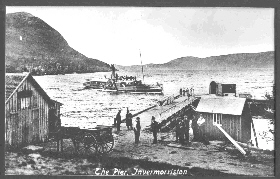
The Gondolier at the pier around 1910
The steamer would be in at six o'clock in the morning. And you could go to Inverness in about three hours, and three hours back again, and back here at six with the mail. It was still running in the twenties but I never went on it myself.
After the steamer stopped it was used for coal boats and timber boats. It was a busy place at one time, when the coal boat was in. It was all hands on deck to unload the coal boat which was done by hand. They dropped a bucket into the hold, and the men in the hold filled the bucket up. Then it was lifted up to a lorry or a cart from there and carted round here along the road, back up to the coal yard here, tipped over the chute and the coal fell down into the coal yard. It would be about a hundred tons of coal came in at a time.
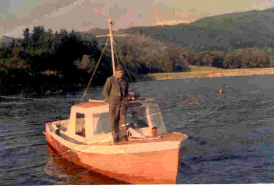
The Vigilant
I used the pier myself for my launch which I had in the fifties. In fact I moved some of the piles so I could get in closer there and had a low pier built there. I bought the launch for fun for myself, but I couldn't get anyone to go out with me on the loch so I went to Fort Augustus and started charging the tourists; charging half a crown a time for a start. And I enjoyed that very much. The boat was about twenty six feet I would say. It had a Perkins P6 diesel engine. It was originally a seaplane tender. I bought it in Aberdeen and I sailed it up from Aberdeen to Inverness in twenty four hours sailing time. Yup, that was an epic, but it was a good adventure at that. It was called The Vigilant. I sold it to Donald Gillies and it still plies on the island of Harris I think, as far as I know. I did quite a bit of business with it. I upped my price to five shillings. But then regulations became tighter and I could only carry about twelve passengers instead of about twenty. Sometimes more than twenty. I went out for an hour at a time and came as far as the Horseshoe from Fort Augustus - about two or three miles.
These rails ran out into the loch and they had a trolley on it which I used to haul the boat ashore in the wintertime and paint it. The rails were used in the tunnels. The bank of the loch there is artificial. There must be millions of tons of rock dropped there. The tunnel ran from the tail race up to the Dundreggan power station below the Dundreggan dam. The tunnel spoil there used to be bigger but it's getting washed away.
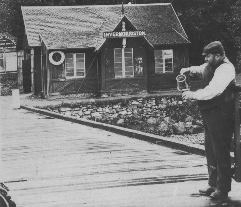
Peter "Ruadh" MacDonald at the pier around 1920.
Now this was the waiting room, which was along the front of it; the store, and also what we called the beer cellar. In later days it was converted into a bar. The beer cellar was where we kept the beer and that end was the saloon. Can you see the boards it's made of? These were wide boards. These were coffin boards. We made coffins here. We made the coffins in that shed. My father and grandfather were undertakers like myself. Still today the undertakers are joiners and my great grandfather, Donald, was a joiner. He was known as the Kerrier because he had a horse and cart or maybe two. He lived at Fasag originally and then at Rose Cottage where the house "Weeford" is now.
This platform was the coalyard. The coal came down the chute from the main road up at the back, tipped over the bank and down the chute. We loaded lorries and carts here. There was a concrete base there.
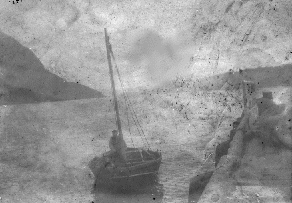
Knockie Ferry at the pier around 1900.
You can see the Knockie burn coming down that gorge there. Now there's a boathouse somewhere at the bottom there and the Knockie ferry ran from this pier to the boathouse over there.
Now this collection of wrecks here - well they're not all mine but that red one there was the mailbus, an 11-seater Austin minibus. The mails came into the pier. We delivered the mails to the Post Office which is near the church there for many years. And probably way back in 1880 when my grandfather became piermaster here, he also became mail conractor delivering mails right up the glen.
That house down there was the pier cottage. My grandfather and father and myself used to rent it from the estate. And before my time, sometimes the family would move in there when they were able to rent out the two bigger houses.

Pat at the garage.
Here's the old garage, and workshop and filling station. There were two pumps on that plinth there. And we sold petrol there from 1920 till 1960. These are the oil cabinets. We sold oil in quart measures out of these cabinets. We also did all sorts of repairs here. At a later stage we used the ramp here for repairing buses and lorries. At one stage we ran six buses out of here. The buses were around 30 seaters.
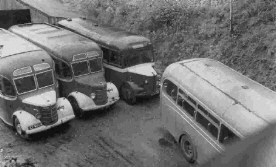
Buses at Pier House
This is the old part of Tigh Na Bruach here. It must be more than a hundred years old. Probably much more than a hundred years. It used to be a store and a garage. The main building was burnt down 10 years ago say and this built instead. There was a bar there and a restaurant for a short time. But the big house was a guest-house for many years. It was built by my grandfather. Colonel Lane bought it from him in 1920.
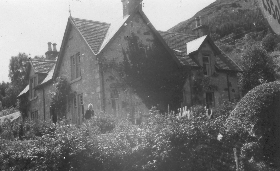
Pier House
My grandfather built the Pier House here in 1908 too. After Colonel Lane, Mrs Paterson had it (Tigh na Bruach) and she developed it as a guest house and her daughter, Sheena Paterson had it until about 1980. Then Graham Duncan bought it and after the main house was burnt he made this part into a pub and built the first new section here.
The top garage here was built the same time as the Pier House. We used to keep the cars inside there every night but now we don't bother. The bottom garage was built from the remains of the old public hall, which was below Steele's and was blown down in about 1928. My father bought the debris and built the garage down there. The payment for that was that he obtained the stone which is now the war memorial, and he brought that down from Inverwick using horse power.